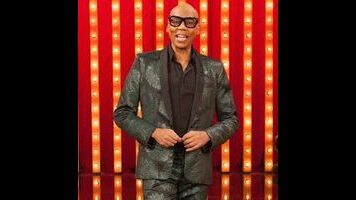RuPaul’s Gay For Play Game Show answers key pop-culture questions

The eighth season of RuPaul’s Drag Race has brought with it a few milestones, including the series’ 100th episode and 100th queen. Drag Race will soon be joined by another RuPaul creation that, while not exactly a spin-off of the show, is still part of the Drag Universe (not to be confused with the Drag U-verse). With the “Snatch Game” now established as one of the most anticipated parts of any Drag Race competition, creator RuPaul is launching the Gay For Play Game Show Starring RuPaul, a half-hour trivia game show that borrows more than just set design from its predecessors.
Gay For Play’s trivia showdown takes place in front of a live studio audience, and not just a rotating lineup of judges led by RuPaul. But the mononymous ringleader still deftly trades quips with the panelists, including Drag Race fixture Michelle Visage (taking the Charles Nelson Reilly seat on the upper right hand side of the panel) and frequent guest judges Carson Kressley and Ross Matthews, as well as viral sensation Todrick Hall. Fans of the Drag Race panel’s dynamic and asides will get a kick out of the Gay For Play interactions, which include plenty of wisecracking from Drag Race season seven runner-up and Miss Congeniality Katya who, if there’s any justice in the world, will get her own spin-off soon enough.
The episodes kick off with RuPaul suggesting that being gay is no prerequisite for playing, though it would probably help. And sure enough, the questions posed cover a broad range of trends and topics, including tracing the etymology of “vajayjay” beyond its “early adopters” like Oprah Winfrey, or answering true-false questions concerning Tom Cruise’s Xenu-inspired dietary habits. The blanks are filled in as bawdy a fashion as ever, with “hard” questions (just one of so many double entendres) being passed around with both reluctance and glee.
Competitors include ordinary folk as well celebrity pairings like Jerry O’Connell and Rebecca Romijn, who play on behalf of ordinary folk. They can choose to rely on their own knowledge or consult the panel of Tops and Bottoms—there are no Squares here. But Gay For Play plays as more than just a super-sized version of Snatch Game, as it also borrows from the Pyramid franchise: Contestants are teamed up with famous counterparts and given 69 seconds to answer as many questions as possible in the lightning round.
That not-at-all arbitrary time limit inspires plenty of snickers, but it also proves to be a narrow window with which to establish a command of a particular pop-culture niche, like Golden Girls trivia or Madonna’s discography. There’s an element of Family Feud as the clock winds down and quick decisions must be made, thereby ratcheting up the tension and reminding viewers of the contest that’s at the center of this good time. And there are certainly many wonderful prizes to be won, which are slowly revealed by the show’s dancers, who use strategically placed boxes to do their best impression of the Deal Or No Deal models.
RuPaul says his hosting style was inspired by long-running Match Game panelist Charles Nelson Reilly and Hollywood Square’s perennial center square, Paul Lynde. The drag performer’s faux-bickering is a little more playful than Reilly’s, and his double entendres more suggestive (though that’s probably due to evolving network “decency” standards). But when he jokingly pledges to “Make America Gay Again”—a riff on some hateful rhetoric—RuPaul is actually revealing the most important piece of “trivia” on the show, that of the LGBT influence on the game-show landscape and, by extension, pop culture. It’s an influence that’s demonstrated by the host’s homage, as well as the knowledge within the categories—though sexual preferences won’t necessarily dictate a love for Death Becomes Her. That LGBT presence is at once obvious and invisible in game shows past, but Gay For Play reminds us just how long it’s been there.